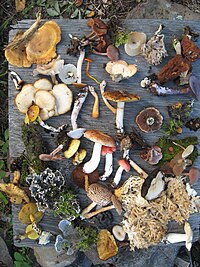
Photo from wikipedia
Significance Persistently diverse microbial communities are one of biology’s great puzzles. Using a modeling framework that accommodates high mutation rates and a continuum of species traits, we studied microbial communities… Click to show full abstract
Significance Persistently diverse microbial communities are one of biology’s great puzzles. Using a modeling framework that accommodates high mutation rates and a continuum of species traits, we studied microbial communities in which antagonistic interactions occur via the production of, inhibition of, and vulnerability to toxins (e.g., antibiotics). Mutation size and mobility enhanced microbial diversity and temporal persistence to extraordinarily high levels. These findings—including the discovery that the duration of the transient phase in community assembly provides a guide to equilibrial diversity—highlight the potentially critical role that antagonistic interactions play in promoting the diversity of bacterial systems. Such interactions, together with resource-driven interactions and spatial structure, may drive the enigmatic levels of biodiversity seen in microbial systems. The assembly and maintenance of microbial diversity in natural communities, despite the abundance of toxin-based antagonistic interactions, presents major challenges for biological understanding. A common framework for investigating such antagonistic interactions involves cyclic dominance games with pairwise interactions. The incorporation of higher-order interactions in such models permits increased levels of microbial diversity, especially in communities in which antibiotic-producing, sensitive, and resistant strains coexist. However, most such models involve a small number of discrete species, assume a notion of pure cyclic dominance, and focus on low mutation rate regimes, none of which well represent the highly interlinked, quickly evolving, and continuous nature of microbial phenotypic space. Here, we present an alternative vision of spatial dynamics for microbial communities based on antagonistic interactions—one in which a large number of species interact in continuous phenotypic space, are capable of rapid mutation, and engage in both direct and higher-order interactions mediated by production of and resistance to antibiotics. Focusing on toxin production, vulnerability, and inhibition among species, we observe highly divergent patterns of diversity and spatial community dynamics. We find that species interaction constraints (rather than mobility) best predict spatiotemporal disturbance regimes, whereas community formation time, mobility, and mutation size best explain patterns of diversity. We also report an intriguing relationship among community formation time, spatial disturbance regimes, and diversity dynamics. This relationship, which suggests that both higher-order interactions and rapid evolution are critical for the origin and maintenance of microbial diversity, has broad-ranging links to the maintenance of diversity in other systems.
Journal Title: Proceedings of the National Academy of Sciences of the United States of America
Year Published: 2021
Link to full text (if available)
Share on Social Media: Sign Up to like & get
recommendations!